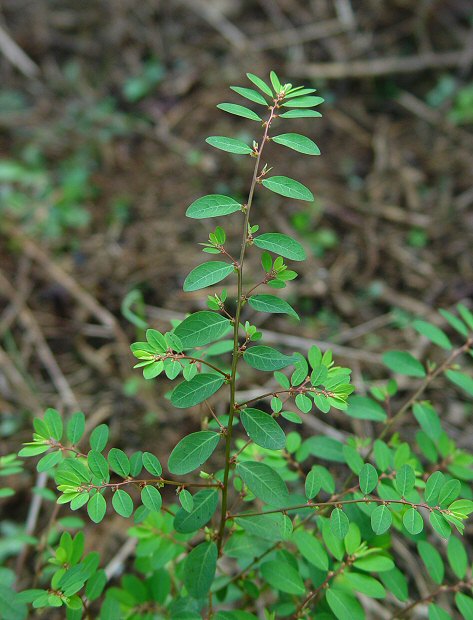Phyllanthus caroliniensis Walter
Carolina Leaf-Flower

Native
CC = 5
CW = 0
MOC = 42
© DETenaglia
Phyllanthus caroliniensis WalterCarolina Leaf-Flower | |
 |
Native CC = 5 CW = 0 MOC = 42 |
© DETenaglia |
|
Family - Euphorbiaceae Habit - Fibrous-rooted monoecious annual forb. Stems - Arched to ascending, to 40 cm, solitary, with few to several spreading to loosely ascending branches, the branches arranged in 2 ranks. Leaves - Alternate, simple, entire, short-petiolate, 2 ranked, giving the plant a flattened appearance. Blades 6-25 mm long, oval to obovate, rounded at the tip, both surfaces green, glabrous. Stipules 1-2 mm long, scalelike, usually uniformly tan to reddish brown at maturity.
Inflorescence - Axillary clusters with 1 staminate and often 1-3 pistillate flowers. Staminate flowers often concentrated toward stem tips.
Flowers - Calyces deeply 6-lobed, those of the staminate flowers 0.5-0.7 mm long, those of the pistillate flowers 0.8-1.5 mm long at flowering, the lobes narrowly oblong, usually with a yellowish green central stripe and white margins, rounded at the tip, persistent at fruiting. Petals absent. Nectar disc with 6-lobes, these broadly rounded at the tip. Staminate flowers with 3 free stamens. Pistillate flowers with the ovary 3-locular and 2 ovules per locule, the 3 styles separate or nearly so, each deeply 2-lobed, each lobe slightly broadened into an inconspicuous terminal stigma.
Fruits - Fruits depressed-globose, 1.5-2.0 mm in diameter. Seeds 0.8-1.1 mm long, gray to reddish brown.
Flowering - June - October. Habitat - Streambanks, pond margins, sloughs, bottomland forests, ravines, moist swales, fields, moist, disturbed areas. Origin - Native to U.S., Central and South America. Lookalikes - P. polygonoides. Other info. - This little species is common in the Mississippi Lowlands division of Missouri, and scattered in other locations in the state, mostly south of the Missouri River, and in the eastern quadrant of the continental U.S. It is easily identified by its unique planar appearance, with alternate branches having leaves which are typically much smaller than main stem leaves. Confirmation is provided by the axillary flowers and leaves. These are small and, being located mostly underneath the plant, not usually readily visible from above. Photographs taken off Lee Rd 54, Lee County, AL., 8-26-04 (DETenaglia); also near Neelyville, Ripley County, MO, 8-27-2015, and at Catawissa Conservation Area, Franklin County, MO, 9-10-2017 (SRTurner). |